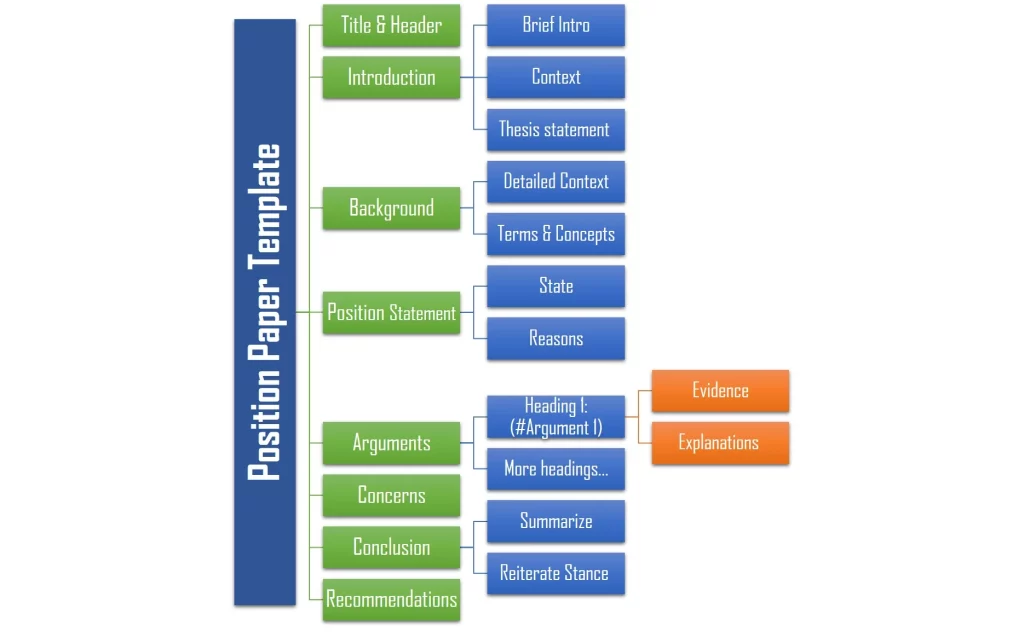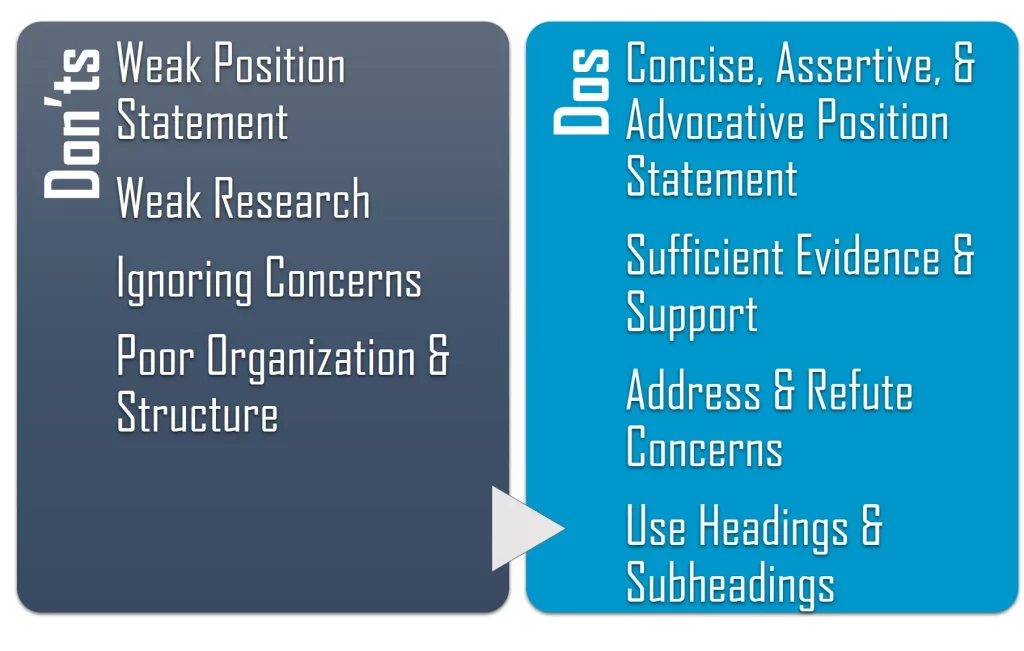
A position paper is a written document that presents an individual or an organization’s stance, viewpoint, or position on a particular issue or topic. It is a persuasive essay that outlines and supports a specific position or argument, often related to a controversial or debatable subject. Position papers are commonly used in various contexts, including academia, politics, diplomacy, business, policy, and advocacy.
Here is a sample position paper:
Sample Model UN Position Paper on Climate Change
Key Characteristics
- Clear Position: A position paper takes a clear and specific stance on an issue. It is not meant to be neutral or purely informative; rather, it aims to advocate for a particular viewpoint.
- Research-Based: To support the position, a well-structured position paper relies on research and evidence from credible sources. This can include facts, statistics, expert opinions, and examples.
- Persuasive Argumentation: Position papers are persuasive in nature. They use persuasive writing techniques to convince the reader of the validity and importance of the position being presented.
- Structure: Typically, position papers follow a specific structure that includes an introduction, a statement of the position, the presentation of evidence and arguments, counterarguments (sometimes), and a conclusion.
- Audience: The intended audience of a position paper can vary. It may be written for decision-makers, policymakers, the general public, academic peers, or other specific groups.
- Clarity and Conciseness: Position papers should be well-organized, clear, and concise. They aim to communicate the position and its supporting arguments in a straightforward manner.
- Citations and References: Proper citation of sources is essential to maintain the credibility of the paper. Position papers often include a bibliography or reference section.
In academic settings, position papers are used for classroom assignments, debates, and Model United Nations (MUN) conferences. In diplomatic and political contexts, they are used to express a nation’s or organization’s stance on international issues. In business, they can be used to articulate corporate positions on relevant matters. Overall, the purpose of a position paper is to contribute to a well-informed discussion or decision-making process by providing a clear, well-reasoned perspective on a given topic.
General Format
- Title: Include a clear and concise title that reflects the topic and position.
- Header/Footer: Include your name, date, and any relevant identification (such as a class or committee name) in the header or footer.
- Introduction:
- Background:
- Position Statement:
- Arguments and Evidence:
- Counterarguments (Optional):
- Conclusion:
- Recommendations or Call to Action (Optional):
- Bibliography or References:
- Appendices (Optional):
It’s essential to maintain a professional and organized format throughout your position paper. Adhering to a consistent structure helps readers understand and engage with your arguments effectively. Additionally, pay close attention to grammar, spelling, and overall clarity in your writing to enhance the readability of your position paper.
Steps on How to Write
- Choose a Topic:
- Research the Topic:
- Formulate Your Position:
- Outline Your Arguments:
- Gather Supporting Evidence:
- Address Counterarguments (Optional):
- Organize Your Paper:
- Write the Introduction:
- Develop the Body:
- Conclude Effectively:
- Edit and Proofread:
- Seek Feedback:
- Finalize Your Paper:
- Create a Bibliography:
- Submit Your Position Paper: If you’re writing the paper for an assignment or specific context, submit it according to the provided instructions and deadlines.
Remember that the effectiveness of your position paper depends on the quality of your research, the strength of your arguments, and the clarity of your writing. Tailor your approach to meet the specific requirements of your assignment or context.
Choosing a Suitable Topic
- Understand the Assignment: First, ensure you understand the specific guidelines and requirements provided for the position paper. These may include word limits, formatting, and any provided topics or themes.
- Research and Interest: Conduct preliminary research on potential topics within the broader theme provided. Choose a topic that genuinely interests you and aligns with your background knowledge or expertise. This will make the writing process more engaging and meaningful.
- Relevance: Select a topic that is currently relevant and significant on the global stage. Consider issues that have real-world impact and importance.
- Clarity of Position: Ensure that you can articulate a clear and defensible position on the chosen topic. Your position should be specific, concise, and well-reasoned.
- Scope: Consider the scope of the topic and the depth of research required. Make sure the chosen topic is neither too broad nor too narrow for the assignment’s requirements.
- Controversy and Counterarguments: Topics that have multiple perspectives, debates, or controversial aspects can make for strong position papers. Be prepared to address counterarguments and provide a well-rounded view.
- Availability of Sources: Verify that there are sufficient credible sources and research materials available on the chosen topic. Adequate research materials are essential for constructing a well-supported position.
- Global Impact: Think about the global impact of the chosen topic. Does it affect multiple countries or regions? Is it part of international discussions or agreements?
- Practicality: Consider the practicality of your proposed solutions or recommendations. Are they feasible and aligned with international norms and standards?
- Alignment with Delegation: If you’re participating in a Model United Nations (MUN) conference, ensure that the chosen topic aligns with the position of the country or delegation you are representing.
- Consultation: If unsure, seek advice or feedback from peers, teachers, or experts who may have insights on the topic.
- Passion and Engagement: Finally, choose a topic that you are passionate about. Your enthusiasm and commitment will shine through in your position paper, making it more compelling and persuasive.
Overall, the process of choosing a topic for a position paper should involve a balance of personal interest, research availability, global relevance, and clarity of position.
8 Major Mistakes to Avoid in a Position Paper

Writing a position paper requires attention to detail and careful planning to avoid common mistakes that can diminish the effectiveness of your argument. Here are eight major mistakes to avoid in a position paper, along with tips on how to avoid them:
- Unclear or Weak Position Statement:
- Insufficient Research:
- Lack of Evidence and Support:
- Ignoring Counterarguments:
- Poor Organization and Structure:
- Overly Emotive Language:
- Failing to Cite Sources:
- Grammar and Spelling Errors:
By being aware of these common mistakes and taking proactive steps to avoid them, you can enhance the quality and impact of your position paper. Thorough research, clear writing, and proper organization are key elements in crafting a compelling and persuasive position paper. Lastly, seeking feedback from peers, instructors, or writing centers can be invaluable in identifying and correcting potential mistakes in your position paper.
Frequently Asked Questions (FAQs)
-
How do I choose a relevant topic for my position paper?
Choosing a relevant topic is a crucial first step. Consider the following tips:
- Select an issue that genuinely interests you; your passion will reflect in your writing.
- Ensure your topic is current, debatable, and has sufficient research material available.
- Research potential topics to gauge the depth and breadth of information available.
- Consider your target audience and their interests when making your selection.
-
What are the key components that should be included in my position paper?
The key components of a position paper typically include:
- Introduction: Provides context and states your position.
- Background: Offers necessary information about the issue.
- Position Statement: Clearly presents your stance.
- Arguments: Supported by evidence, present your main points.
- Counterarguments (if applicable): Address opposing viewpoints.
- Conclusion: Summarizes your position and main points.
- Recommendations (if needed): Suggest actions or solutions.
-
How can I effectively research and gather evidence to support my position?
To conduct effective research and gather evidence:
- Utilize academic databases, libraries, and reliable online sources.
- Look for peer-reviewed articles, government reports, and authoritative publications.
- Take notes, organize your findings, and keep track of your sources.
- Consider different perspectives to get a well-rounded understanding of the issue.
- Cite your sources properly to give credit and ensure credibility.
-
What are some persuasive writing techniques I can use to create a strong position paper?
To create a persuasive position paper:
- Use strong, clear language and avoid vague statements.
- Appeal to emotions and logic in your arguments.
- Employ rhetorical devices, such as anecdotes or metaphors.
- Address counterarguments and offer well-reasoned responses.
- Organize your paper logically, with a clear structure and transitions.
-
Are there specific guidelines or requirements for my assignment that I need to follow?
Always follow the guidelines provided for your assignment. These guidelines may include:
- Word count or page length requirements.
- Specific formatting styles (e.g., APA, MLA, Chicago).
- Submission deadlines.
- Target audience or purpose of the position paper.
- Any additional sections or components required.
-
How do I properly cite sources and create a bibliography for my position paper?
To properly cite sources and create a bibliography:
- Use the citation style specified in your assignment guidelines.
- Include in-text citations for quotes, paraphrases, and references.
- List all your sources in a bibliography or reference section.
- Ensure consistency and accuracy in your citations.
-
How can I make my introduction and conclusion impactful and engaging?
For an impactful introduction and conclusion:
- Introduction: Start with a compelling hook or a relevant quote to grab the reader’s attention. Provide context and state your position clearly.
- Conclusion: Summarize your main points. Restate your position emphatically. End with a thought-provoking statement or a call to action.
-
Do you have any tips for managing my time and staying organized during the writing process?
To manage your time effectively and stay organized:
- Create a schedule with clear milestones, including research, drafting, and editing.
- Break down tasks into manageable chunks.
- Use tools like calendars and to-do lists to track your progress.
- Avoid procrastination by setting specific deadlines for each step of the process.
- Seek feedback from peers or instructors to stay on track and make improvements as you go.
-
How long are position papers?
While there are typical word and page count ranges for position papers, the specific length can vary based on the context and guidelines provided by the organization or conference.
- Position papers are typically concise and focused documents. They are often in the range of 1,000 to 1,500 words.
- Position papers are typically formatted with double spacing, standard margins (i.e. 1″), and font sizes (e.g., 12-point Times New Roman or Arial).
- If you are writing a position paper for a specific organization or conference, be sure to review their guidelines or instructions. They may specify the preferred length or format for position papers.
- Regardless of length, it’s crucial to maintain clarity and conciseness in your position paper. Avoid unnecessary repetition or verbosity.
It’s important to adhere to any specific requirements and focus on presenting a well-structured and compelling argument within the designated word limit.
-
Position paper vs. research paper?
- Purpose: Position papers present a specific viewpoint or recommendation, while research papers contribute to existing knowledge.
- Content: Position papers focus on opinions and arguments, while research papers delve into comprehensive research and analysis.
- Length: Position papers are shorter (1,000-1,500 words), and research papers are longer (5,000-10,000+ words).
- Citations: Position papers cite sources to support arguments, but research papers extensively cite existing research.
- Audience: Position papers target specific decision-makers, while research papers target broader academic audiences.
- Structure: Position papers have a focused structure, and research papers follow a comprehensive format with various sections.
In conclusion, the key to writing a successful position paper is to thoroughly research your topic, present a clear and well-supported stance, address counterarguments, and use persuasive writing techniques to engage your audience. Additionally, adhering to proper formatting, maintaining a professional and objective tone, citing sources correctly, and ensuring clarity and organization throughout your paper are essential for success.
